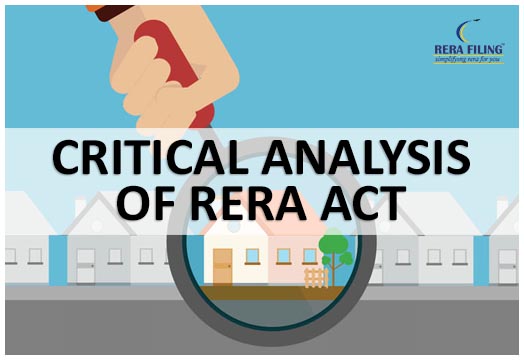Critical Analysis of RERA Act, 2016

- General
- Author: Shreya Uppal
Highlights
The basic intention to bring this law was to bring transparency amongst the real estate transactions so that the interests of the consumers can be protected and malpractices done by the developers can be minimized or eliminated.
A Control Mechanism was surely needed in the Real Estate Sector contributing a good % in India’s GDP.
The accountability and responsibility measures that were taken to come up with RERA were the demand of this industry.
Although it has been 3 years after the enforcement of the RERA Act, 2016
The Real Estate (Regulation and Development) Act, 2016 came into force on May 1, 2016 with 69 out of 90 sections notified by Ministry of Housing and Urban Poverty Alleviation. The basic intention to bring this law was to bring transparency amongst the real estate transactions so that the interests of the consumers can be protected and malpractices done by the developers can be minimized or eliminated. A Control Mechanism was surely needed in the Real Estate Sector contributing a good % in India’s GDP. The accountability and responsibility measures that were taken to come up with RERA were the demand of this industry. Although it has been 3 years after the enforcement of RERA Act but the proper implementation geared from May 1, 2017 in most of the states of the country.
No doubt we cannot overlook the benefits the homebuyers have gained due to the implementation of this Act!!! However, some lacunae are still to be covered by the RERA Act, 2016.
Some of the observations of the uncovered gaps of the RERA Act, 2016 are explained below:
1. Website not launched
The proper implementation of the RERA Act, 2016 started in May, 2017 in most of the states. However, there are still some states and Union Territories which have not even the launched website of their respective Real Estate Authority as on April, 2019. States like- Assam, Arunachal Pradesh, Tripura, Lakshadweep, Kerala, etc. are a perfect example of the earlier mentioned line.
2. Poor IT Infrastructure in some states
States like Karnataka are lacking behind in the terms of IT (Information Technology) synchronization and implementation. There are some gaps in its implementation where payments are not being done in a proper manner with a normal speed.
3. Lack of Real-time updation
Some states have a website that puts out the list of complaints against project proponents. Judgment copies and copies of the complaints are not uploaded on a real-time basis which appears to be major miss-out information for the homebuyers.
4. Insufficient Recovery powers with RERA
This appears to be a major lacuna which fails all the orders passed by the RERA authorities of their respective states made in the favor of the homebuyers. Most of the aggrieved buyers facing the problem of not getting the penalty imposed on the developer. The developers are not complying with the orders and therefore the orders are becoming just a piece of paper. Although the RERA authority has requested the DC (District Commissioners) of various jurisdiction to take sufficient measures to recover the penalty amounts.
5. Lack of Single Window Clearance
The difficulty arises when the development of the real estate project involves many phases then the approval is to be sought for every project. Due to the lack of a single window clearance, the development of the project will face hindrance and will get delayed. For instance, if a project is made in Delhi, then the developer is required to get 41 permissions or clearance in a span of 60 days. Whereas Section 32 of the act says that it is the function of the RERA to make a recommendation to the appropriate government of the competent authority on the creation of a single window system in order to see if the project is completed timely.
6. Increase in debt of developers
Companies listed in the Bombay Stock Exchange has summed up a debt of Rs.52598 Cr. which is 7.3% higher than that of the debt incurred a year ago. With the coming of RERA provisions, the act has put a bar on the diversion of the fund. The deposits in this account shall be used only for meeting the expenses of land and construction. The use of money has to be certified by a professional such as a chartered accountant.
Every matter needs to be analyzed in both perspectives taking into account all its pros and cons…. Thanks to the RERA provisions for many facilities and benefits but at the same time some things require improvements!!!
For Project Registration, Click here
Latest Blogs
- Rights of buyer under RERA
- Delhi RERA Agent Procedure for Re-validation or Renewal
- MahaRERA guidelines for Real Estate agent training and certification
- Force Majure Clause in RERA
- All you need to know about Relinquishment Deed
- RERA Agent Renewal in Maharashtra
- What is Title Verification and Search Report?
- Revocation under the RERA Act
- RERA Limitations
- Homebuyers right in case of insolvency
Copyright © 2023 RERA Filing. All rights reserved.
 Rera
Act
Rera
Act
 Maharashtra
Maharashtra Karnataka
Karnataka Andhra Pradesh
Andhra Pradesh Uttar Pradesh
Uttar Pradesh